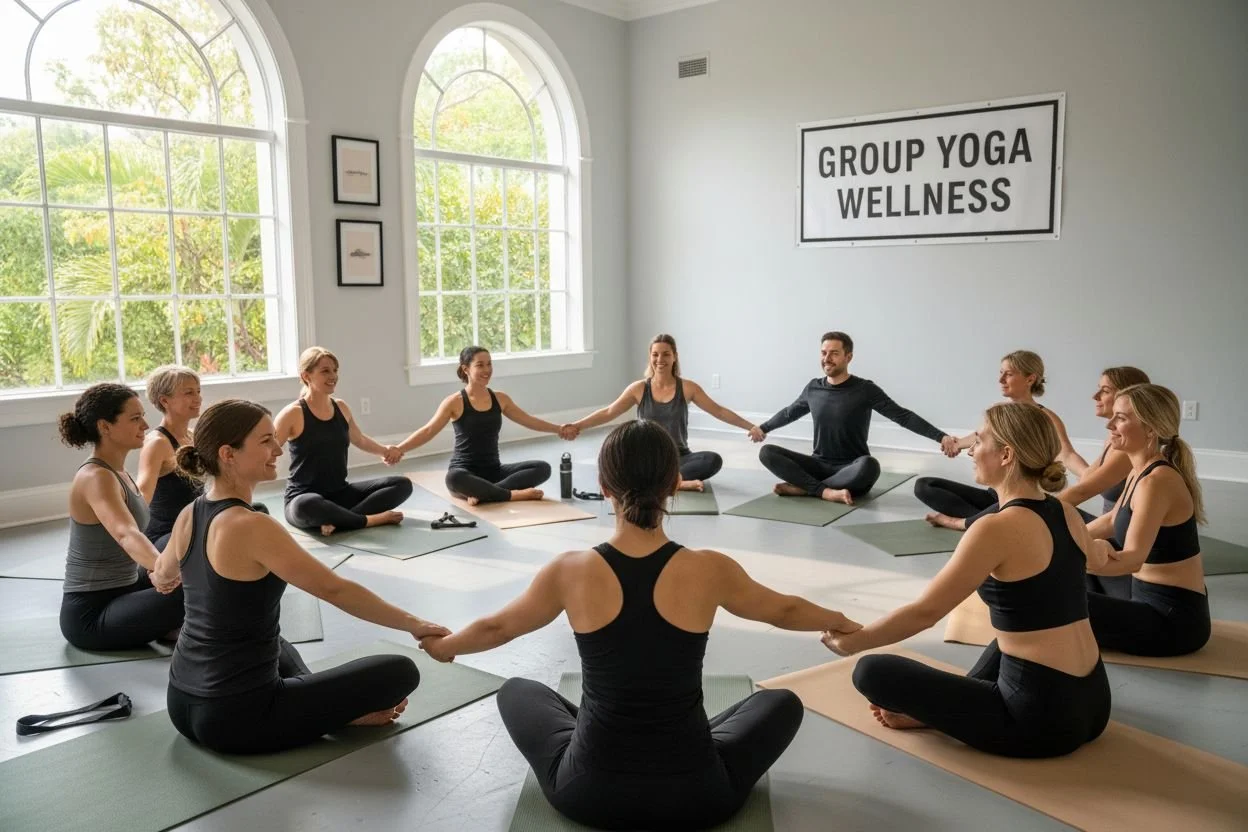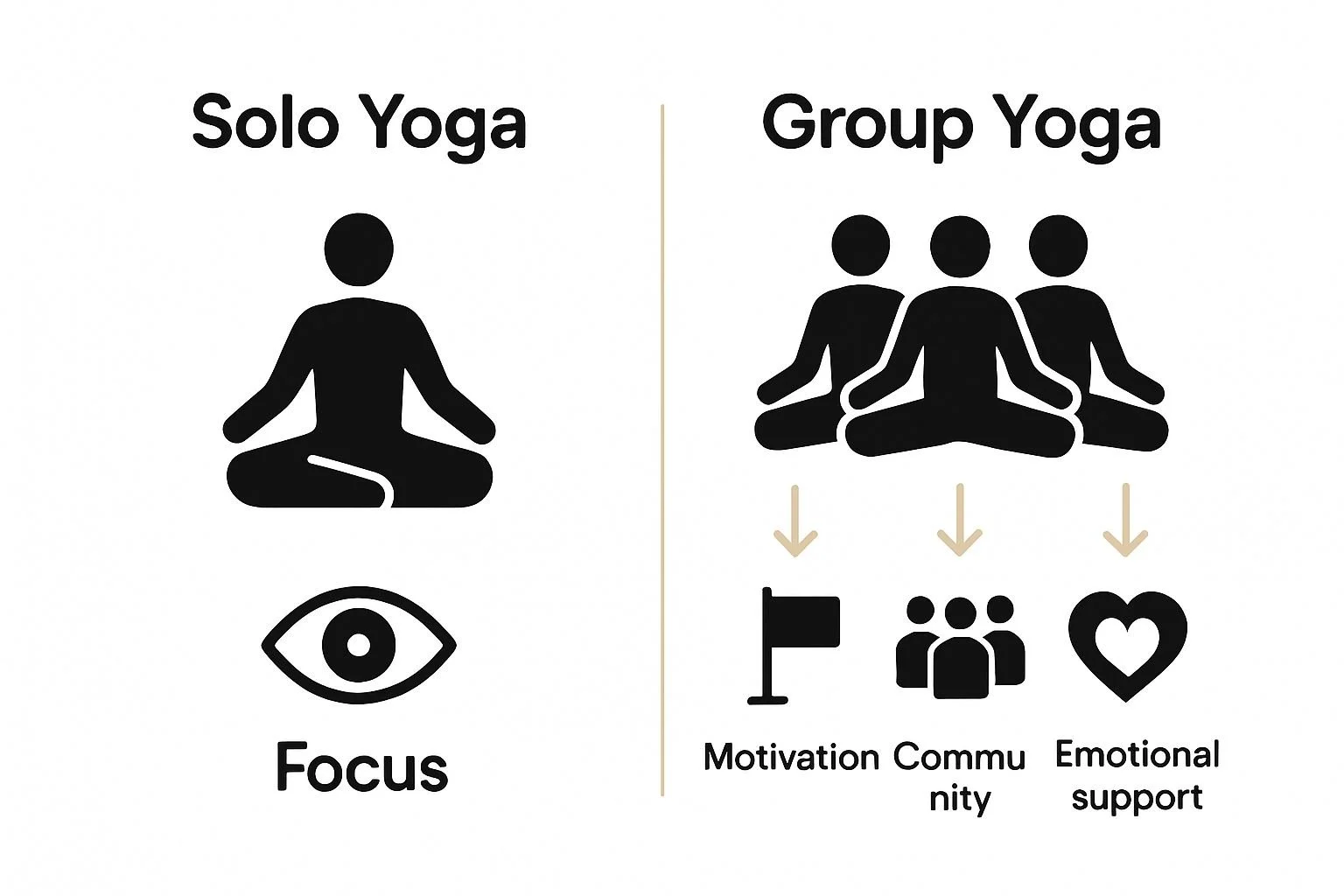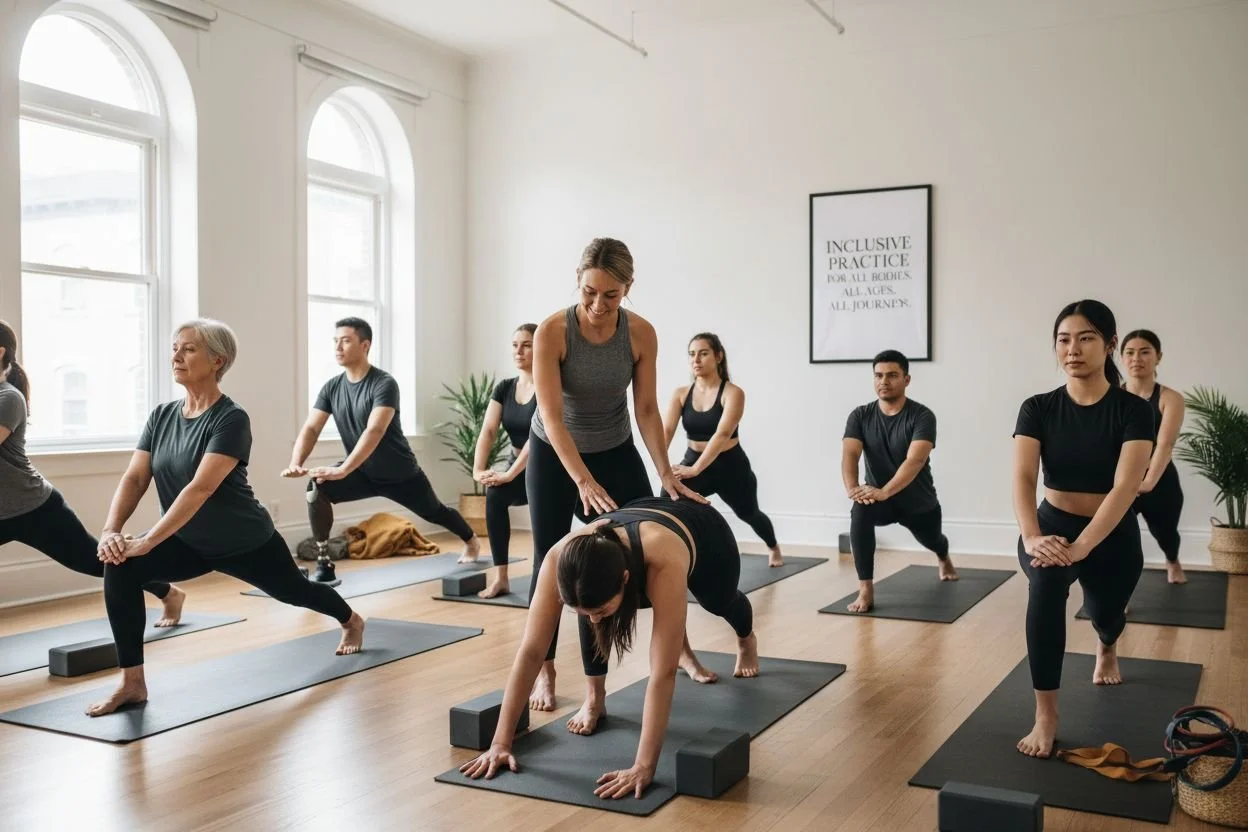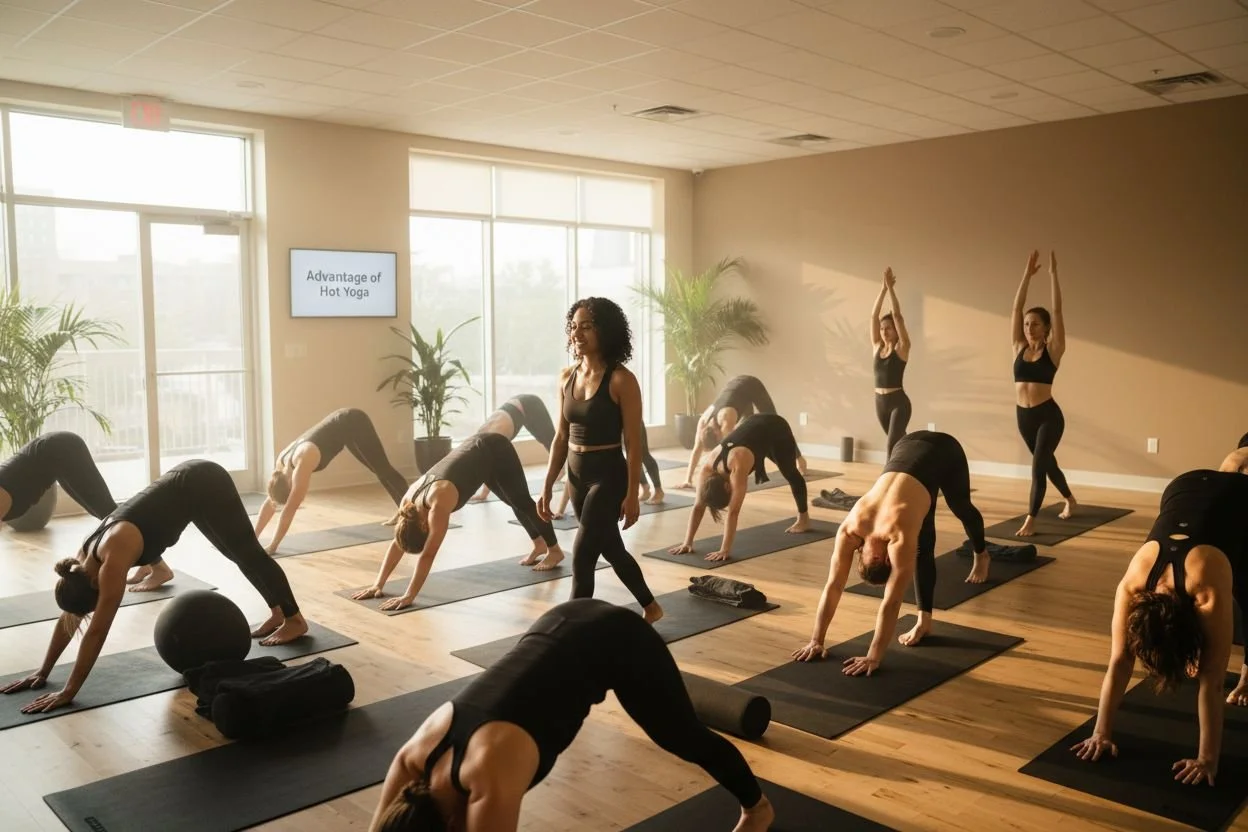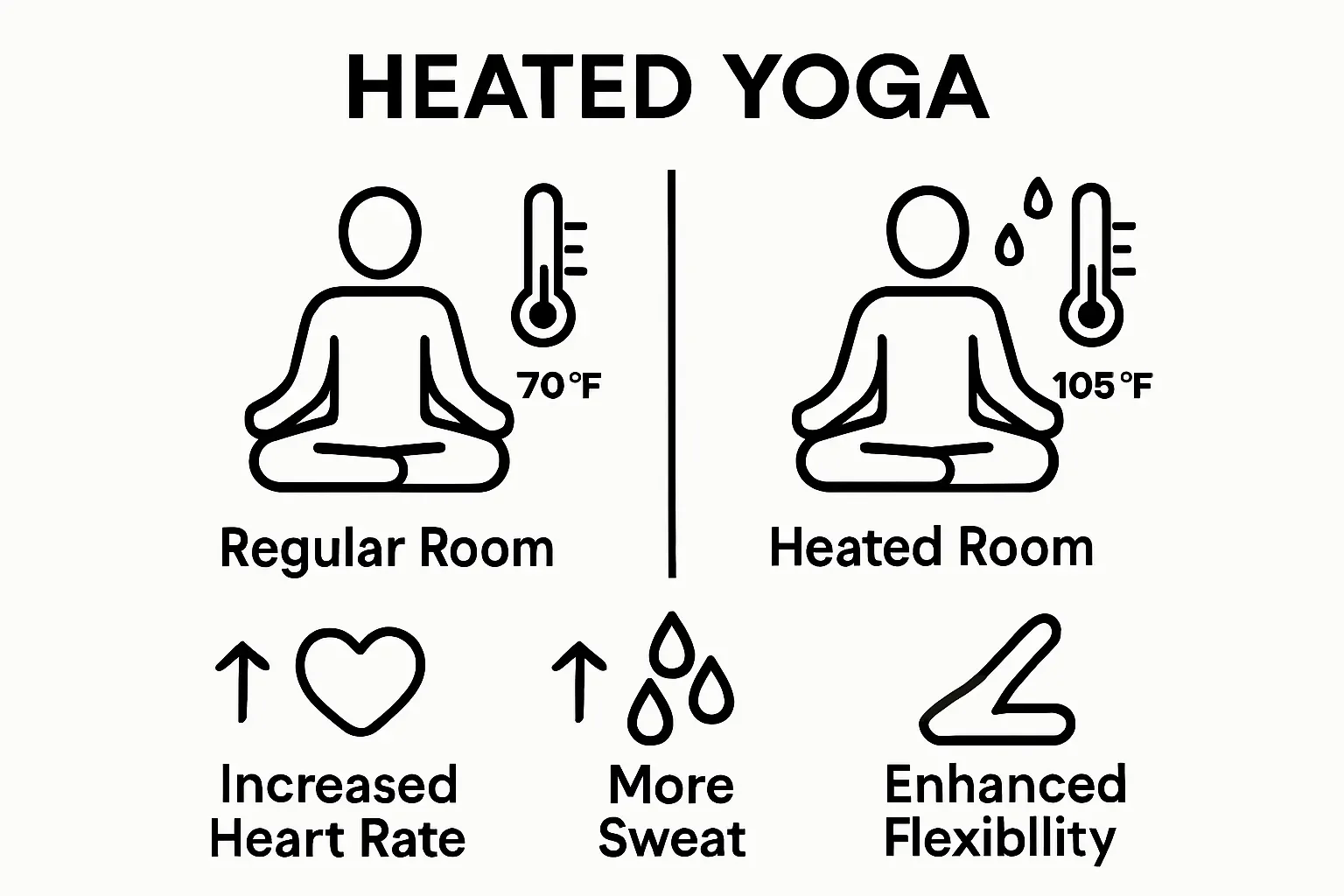Understanding Why Group Yoga Classes Enhance Wellness
Heather Rice
Group yoga classes are changing the way people think about wellness. People who join these sessions report significantly lower anxiety and depression while building real social connections. Most think yoga is just a solo activity with a mat and some stretches. That idea misses the point. The real magic happens when everyone moves and breathes together, creating something far more powerful than working out alone.
Table of Contents
Quick Summary
| Takeaway | Explanation |
|---|---|
| Group classes enhance motivation and commitment | Participants benefit from a supportive environment that boosts individual performance through shared energy and focus. |
| Community fosters emotional and psychological growth | Group dynamics create a safe space for personal exploration, enhancing emotional intelligence and self-awareness. |
| Collective practice improves physical and mental health | Shared yoga experiences reduce anxiety and depression while promoting overall well-being through mutual support. |
| Inclusive environments cater to all practitioners | Group classes adapt to varying skill levels, ensuring that everyone can participate comfortably and grow together. |
| Yoga communities offer transformative experiences | Engaging with diverse groups leads to personal growth, expanded opportunities, and richer wellness journeys beyond physical practice. |
What Are Group Yoga Classes and Their Purpose?
Group yoga classes represent a dynamic and collaborative approach to practicing yoga, where individuals come together in a shared space to engage in physical and mental wellness practices. Research from Harvard Medical School demonstrates that these collective sessions offer significantly more than individual practice, creating a supportive environment for holistic health development.
The Collective Wellness Experience
Unlike solitary yoga practices, group yoga classes provide a unique social dimension to wellness. Participants share a collective energy and motivation that naturally enhances individual performance and commitment. The synchronized movements, collective breathing, and shared focus create a powerful synergy that amplifies the traditional benefits of yoga.
Key characteristics of group yoga classes include:
Structured guidance from a professional instructor
Synchronized group movements and breathing techniques
A supportive and inclusive community environment
Opportunities for social interaction and connection
Understanding the Purpose and Benefits
The primary purpose of group yoga classes extends beyond physical exercise. These sessions are designed to cultivate mental clarity, emotional balance, and community connection. Participants experience not just physical flexibility and strength, but also profound psychological benefits. Check out our guide on modern fitness practices to explore how group yoga integrates into contemporary wellness approaches.
Group yoga classes create a transformative space where individuals can simultaneously work on personal growth while feeling part of a larger, supportive collective.
To help clarify the unique contributions of group yoga classes, the following table compares group versus individual yoga experiences in key areas discussed in the article.
Group Yoga Classes vs Individual Practice
| Aspect | Group Yoga Classes | Individual Yoga Practice |
|---|---|---|
| Social Connection | Strong, fosters community and belonging | Limited, often practiced alone |
| Motivation | Enhanced by collective energy and support | Depends on personal discipline |
| Emotional Support | High, shared accountability and encouragement | Minimal, self-driven |
| Adaptability | Offers modifications for all skill levels | Self-modification required |
| Personal Growth Opportunities | Expanded through workshops and group events | Based on personal initiative |
| Physical/Wellness Benefits | Amplified by group synergy | Self-paced and individualized |
| Stress/Anxiety Reduction | More pronounced due to social dynamics | Depends on consistency and self-motivation |
| Through shared practice, participants learn, challenge themselves, and develop a deeper understanding of yoga’s holistic principles. | ||
The Importance of Community in Yoga Practice
Community is the heartbeat of transformative yoga practice, creating a powerful ecosystem that transcends individual physical movements and breathwork. Research demonstrates that group-based interventions significantly enhance social connectedness, reducing stress and increasing overall well-being.
Building Collective Energy and Motivation
Yoga communities provide more than just shared physical space. They generate a collective energy that motivates practitioners to push beyond personal limitations. When individuals practice together, they create a supportive environment where mutual encouragement becomes a catalyst for personal growth. The collective momentum transforms individual practice into a shared journey of wellness.
Key elements of community in yoga practice include:
Mutual support and accountability
Shared learning experiences
Emotional and psychological reinforcement
Opportunities for interpersonal connection
Psychological and Social Benefits of Yoga Communities
Beyond physical alignment and technique, yoga communities offer profound psychological benefits. They create safe spaces for personal exploration, emotional healing, and social connection. Explore our insights on local yoga studio experiences to understand how community transforms individual practice.
By participating in group yoga, practitioners develop a sense of belonging, reduce feelings of isolation, and cultivate deeper self-awareness through collective experiences. The shared vulnerability and mutual respect within these communities enable individuals to grow not just physically, but emotionally and spiritually.
This table summarizes the main psychological and social benefits that yoga communities offer, as detailed in the article, to provide a clear overview for readers.
Benefits of Group Yoga Practice
| Benefit | Description |
|---|---|
| Sense of Belonging | Builds connection and reduces feelings of isolation |
| Emotional Support | Provides a safe space for emotional healing and mutual encouragement |
| Enhanced Self-Awareness | Facilitates deeper awareness through collective learning experiences |
| Stress Reduction | Lowers stress by creating a supportive environment |
| Improved Emotional Regulation | Helps participants develop better emotional management skills |
| Mutual Respect | Encourages vulnerability and builds trust within the group |
| Social Connection | Offers opportunities for meaningful interpersonal interactions |
Benefits of Group Dynamics for Mental and Physical Health
Group yoga dynamics create a powerful synergy that amplifies individual wellness potential, transforming personal practice into a holistic healing experience. Research from clinical studies reveals that participation in group physical activities significantly reduces anxiety and depression while enhancing overall mood and psychological resilience.
Psychological Wellness Through Collective Engagement
Group dynamics in yoga practice offer profound mental health benefits beyond individual exercise. The shared environment creates a supportive ecosystem where practitioners experience emotional validation, mutual encouragement, and collective motivation. Participants naturally develop deeper self-awareness and emotional intelligence through synchronized movements and shared breathing techniques.
Key psychological advantages of group yoga dynamics include:
Reduced feelings of isolation
Enhanced emotional regulation
Increased sense of belonging
Improved stress management capabilities
Collective emotional support and understanding
Physical Health and Performance Enhancement
Beyond mental wellness, group yoga dynamics scientifically improve physical performance and health outcomes. The collective energy motivates individuals to challenge personal boundaries, leading to more consistent practice and accelerated physical improvement. Learn more about our yoga practice insights to understand the transformative potential of group dynamics.
Collective practice creates a natural accountability system where participants inspire and challenge each other. The synchronized movements, shared breathing, and mutual support enable practitioners to explore physical capabilities more confidently and effectively than solitary practice, ultimately promoting comprehensive wellness across mental and physical dimensions.
How Group Yoga Classes Support Different Yoga Styles
Group yoga classes serve as versatile platforms that accommodate diverse yoga practices, allowing practitioners to explore multiple styles within a supportive collective environment. Research demonstrates that group settings enable participants to experience various yoga approaches, from gentle restorative practices to more dynamic and intense modalities.
Adapting to Individual Needs Within Collective Practice
Group yoga classes excel at providing customized experiences that respect individual physical capabilities while maintaining a cohesive class structure. Instructors skillfully modify poses, offer alternative movements, and provide hands-on adjustments that allow practitioners with different fitness levels and physical constraints to participate comfortably. This adaptive approach ensures inclusivity and personal growth within a shared practice.
Key strategies for supporting diverse yoga styles include:
Offering multiple pose modification options
Providing varied difficulty levels within single sessions
Encouraging personal pace and individual exploration
Facilitating targeted adjustments for different body types
Creating flexible learning environments
Exploring Yoga Style Diversity
From Hatha to Vinyasa, Yin to Power Yoga, group classes create opportunities for practitioners to experience multiple yoga approaches. Check out our comprehensive guide to hot yoga styles to understand the breadth of yoga practices available. The group setting allows participants to safely experiment with different techniques, understand their body's responses, and gradually develop a personalized practice that resonates with their wellness goals.
Exploring Diverse Yoga Communities and Practice Opportunities
Yoga communities represent powerful platforms for personal transformation and collective wellness, transcending traditional exercise boundaries to create inclusive spaces of healing and growth. Research highlights that expanding yoga practice opportunities significantly supports mental and physical health across diverse populations.
Breaking Barriers Through Inclusive Practice
Diverse yoga communities challenge conventional fitness narratives by creating welcoming environments that celebrate individual differences. These spaces recognize that wellness is not a one-size-fits-all experience but a personalized journey of physical, mental, and spiritual exploration. Practitioners find connection through shared vulnerability and mutual respect, regardless of age, body type, fitness level, or background.
Key elements of inclusive yoga communities include:
Welcoming practitioners of all skill levels
Providing modifications for different physical abilities
Celebrating cultural and personal diversity
Creating judgment-free learning environments
Emphasizing personal growth over competition
Expanding Practice Opportunities and Personal Growth
Yoga communities offer more than physical classes they provide transformative experiences that connect individuals through shared wellness journeys. Explore our guide on yoga workshops to understand the depth of opportunities available. These communities become catalysts for personal development, offering workshops, specialized classes, and collaborative experiences that support holistic well-being beyond traditional exercise paradigms.
Transform Your Wellness Journey with Group Yoga at Amrita
Are you searching for more than just a workout and struggling to find community and motivation in your wellness routine? The article explains how group yoga classes fuel both physical and emotional benefits by building collective energy, accountability, and belonging. If you have ever felt isolated or disconnected from your practice, now is the time to experience the supportive environment that only a dedicated studio can offer.
At Amrita Yoga & Wellness, our group classes are designed for all experience levels, from beginners to advanced yogis. We offer a variety of styles including hot yoga, pilates, and tai chi, each focused on building community and supporting personal growth. Secure your spot in our next session or explore class schedules and descriptions directly on our homepage. Ready to feel healthier and more connected? Your next step toward lasting wellness starts at Amrita Yoga & Wellness. Join now and discover how group yoga can change your practice—and your life.
Frequently Asked Questions
How do group yoga classes enhance overall wellness?
Group yoga classes enhance overall wellness by creating a supportive community atmosphere that encourages participants to improve both physically and mentally. Engage with others in a shared practice, and you may experience heightened motivation and emotional support, leading to a deeper commitment to your wellness journey.
What psychological benefits can I expect from attending group yoga classes?
Attending group yoga classes can significantly reduce feelings of isolation and enhance emotional regulation. By practicing with others, you may develop a stronger sense of belonging and experience increased stress management abilities, which can manifest within a few sessions.
How do group dynamics influence physical performance in yoga?
Group dynamics influence physical performance by fostering a sense of accountability and motivation among participants. When practicing together, individuals often push their limits more than they would alone, potentially leading to faster improvement in strength and flexibility, typically noticeable within 30 to 60 days.
Can group yoga classes accommodate different skill levels and styles?
Yes, group yoga classes can accommodate a variety of skill levels and yoga styles. Instructors commonly provide modifications and alternative poses, allowing participants of all abilities to participate comfortably, so try a class that fits your personal capabilities and interests for optimal growth.
How can I find a yoga community that fits my personal wellness journey?
To find a yoga community that suits your wellness journey, research local studios or classes that prioritize inclusivity and diverse practices. Attend a few different classes to gauge the atmosphere and connections made, which can help you find the right fit for your personal growth and social needs.
What activities do group yoga classes typically include to promote wellness?
Group yoga classes typically include structured guidance from instructors, synchronized movements, and collective breathing techniques. Participate in these activities to reap the full benefits of community engagement, as these elements are designed to enhance both your physical and mental wellness effectively.
